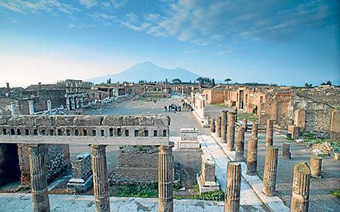Ancient history books are littered with examples of cities that were destroyed, abandoned or swallowed up by the sea. The existence of some have never been proved. The remnants of others can still be visited.
Troy
 Remains of the fabled city from the pages of Homer were discovered in the 19th century in Anatolia in Turkey. Legend has it that, following a siege, the Greeks plundered and then burnt the settlement to the ground. At an ancient mound at Hisarlik, archeologists have found 20ft walls and evidence of nine cities at the site, one of which could be the sacked city.
Remains of the fabled city from the pages of Homer were discovered in the 19th century in Anatolia in Turkey. Legend has it that, following a siege, the Greeks plundered and then burnt the settlement to the ground. At an ancient mound at Hisarlik, archeologists have found 20ft walls and evidence of nine cities at the site, one of which could be the sacked city.
Babylon
 Nebuchadnezzar built the Hanging Gardens of Babylon, once one of the seven wonders of the ancient world, to dazzle the gods and as a testament to his own greatness. Herodotus chronicled its magnificence, despite probably never having seen it, but now, not so much as a hanging basket can be found. The mud-brick walls of the city were discovered in the 19th century, however, along with ruins of the northern palace. The site was controversially re-built under Saddam Hussein. Large chunks of the city's Ishtar Gate can be seen at the Pergamon Museum in Berlin.
Nebuchadnezzar built the Hanging Gardens of Babylon, once one of the seven wonders of the ancient world, to dazzle the gods and as a testament to his own greatness. Herodotus chronicled its magnificence, despite probably never having seen it, but now, not so much as a hanging basket can be found. The mud-brick walls of the city were discovered in the 19th century, however, along with ruins of the northern palace. The site was controversially re-built under Saddam Hussein. Large chunks of the city's Ishtar Gate can be seen at the Pergamon Museum in Berlin.
Akrotiri

This Bronze Age city was inhabited by the Minoan civilization until it was engulfed by a volcano eruption around 1500 BC. Found on the Greek island of Santorini, houses, staircases and some excellent wall-paintings and ceramics have been uncovered, well preserved under the ashes. The eruption could have been large enough for part of the island to sink under the lava into the sea, and may have inspired the legend of Atlantis.
 The eruption of Vesuvius that destroyed the Roman town of Pompeii in AD 79 wasn't quite as devastating as it is sometimes cracked up to be. This wasn't an ordinary little town going about its everyday business as usual – when suddenly, with no warning at all, it was covered in debris from the volcano and preserved as if in aspic. Vesuvius had been rumbling for days, if not weeks. Most of the population, perhaps more than 17,000 out of an original 20,000 or so, managed to escape – taking their prized possessions with them.
The eruption of Vesuvius that destroyed the Roman town of Pompeii in AD 79 wasn't quite as devastating as it is sometimes cracked up to be. This wasn't an ordinary little town going about its everyday business as usual – when suddenly, with no warning at all, it was covered in debris from the volcano and preserved as if in aspic. Vesuvius had been rumbling for days, if not weeks. Most of the population, perhaps more than 17,000 out of an original 20,000 or so, managed to escape – taking their prized possessions with them.
Machu Picchu

The lost city of the Incas was initially thought to have been brought to the attention of the modern world by an American explorer, Hiram Bingham, in 1911, after laying undiscovered since the fall of the Incan Empire in the 1530s. However, a research team recently suggested it was looted more than 40 years previously by a German adventurer with the help of the Peruvian government. The spectacular terraces at the site are now a hugely popular tourist attraction but it remains unclear exactly why the city was built in such a location. The most popular of the current theories concern sacrificial virgins and astronomical alignment.
Petra

Tourists can discover just how hidden this rose-hued city once was for themselves, by approaching the magnificent treasury via the narrow Siq - a near mile-long hidden gorge in the sandstone mountains. There are around 1,000 more tombs, a sacrificial alter and a monastery to explore. Previously known only to Bedouin, it was rediscovered by Swiss traveller Johann Burckhardt in 1812. Hearing talk of a lost city, he disguised himself as an Arab and persuaded guides to take him there on the pretext of making a sacrifice at the tomb of Moses' brother Aaron. The presence of several springs initially persuaded the nomadic Nabataeans to settle at Petra.

While the region still exists, not much is left of the ancient seaport which was destroyed not once but twice, first by the Romans during the Punic war in 146BC. But the city rose again to be a Mediterranean trading port before being sacked by the Arabs in 698 AD. The ruins, scattered across Byrsa Hill in Tunisia, can be visited however and part of an aqueduct is visible.
Tikal

Once the capital of the Mayan civilisation and the seat of rulers such as Stormy Sky and Great Jaguar Paw, Tikal was mysteriously abandoned in about AD 900 and for more than a thousand years was swallowed up by dense vegetation. Guatemalan locals knew about the city, once containing 4,000 buildings and 90,000 inhabitants, but European explorers only discovered it in the 19th century.

Hidden amid the cloud forests of northern Peru, this fortress has only recently been opened up and teams of archeologists are still unearthing human bones while tourists explore the site today. The walled city pre-dates the Incas and the Peruvian tourist board is hoping it will become something of a Machu Picchu for the north. The Chachapoyas people held this forest stronghold which features homes, temples and tombs surrounded by a 70ft stone wall.

Crumbling and weighed-down by the Cambodian jungle, the enormous complex at Angkor, the one-time capital of the Khmer empire, was stumbled upon by French explorer Henri Mouhot over 140 years ago. It contains scores of temples built between the 9th and 14th centuries and is a delight to explore. One theory regarding the demise of the city's inhabitants is that expansion of the complex, thought to have covered 1,150 sq miles, could have disrupted the local environment in the surrounding forests.
Source: Telegraph
VIA «Ten Lost Cities of the Ancient World»
 Remains of the fabled city from the pages of Homer were discovered in the 19th century in Anatolia in Turkey. Legend has it that, following a siege, the Greeks plundered and then burnt the settlement to the ground. At an ancient mound at Hisarlik, archeologists have found 20ft walls and evidence of nine cities at the site, one of which could be the sacked city.
Remains of the fabled city from the pages of Homer were discovered in the 19th century in Anatolia in Turkey. Legend has it that, following a siege, the Greeks plundered and then burnt the settlement to the ground. At an ancient mound at Hisarlik, archeologists have found 20ft walls and evidence of nine cities at the site, one of which could be the sacked city.  Nebuchadnezzar built the Hanging Gardens of Babylon, once one of the seven wonders of the ancient world, to dazzle the gods and as a testament to his own greatness. Herodotus chronicled its magnificence, despite probably never having seen it, but now, not so much as a hanging basket can be found. The mud-brick walls of the city were discovered in the 19th century, however, along with ruins of the northern palace. The site was controversially re-built under Saddam Hussein. Large chunks of the city's Ishtar Gate can be seen at the Pergamon Museum in Berlin.
Nebuchadnezzar built the Hanging Gardens of Babylon, once one of the seven wonders of the ancient world, to dazzle the gods and as a testament to his own greatness. Herodotus chronicled its magnificence, despite probably never having seen it, but now, not so much as a hanging basket can be found. The mud-brick walls of the city were discovered in the 19th century, however, along with ruins of the northern palace. The site was controversially re-built under Saddam Hussein. Large chunks of the city's Ishtar Gate can be seen at the Pergamon Museum in Berlin. 






 The eruption of Vesuvius that destroyed the Roman town of Pompeii in AD 79 wasn't quite as devastating as it is sometimes cracked up to be. This wasn't an ordinary little town going about its everyday business as usual – when suddenly, with no warning at all, it was covered in debris from the volcano and preserved as if in aspic. Vesuvius had been rumbling for days, if not weeks. Most of the population, perhaps more than 17,000 out of an original 20,000 or so, managed to escape – taking their prized possessions with them.
The eruption of Vesuvius that destroyed the Roman town of Pompeii in AD 79 wasn't quite as devastating as it is sometimes cracked up to be. This wasn't an ordinary little town going about its everyday business as usual – when suddenly, with no warning at all, it was covered in debris from the volcano and preserved as if in aspic. Vesuvius had been rumbling for days, if not weeks. Most of the population, perhaps more than 17,000 out of an original 20,000 or so, managed to escape – taking their prized possessions with them. 













